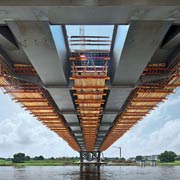
|
contents | technologies | |||||||||
| Elegant arched bridge spanning the Elbe  Below the Waldschloesschen area of the Elbe Valley in Dresden, a road bridge is currently being realised that will connect the eastern and southern districts of the city with areas in the north. PERI has planned and is supplying the formwork for the superstructure of the steel composite bridge, and won over the construction site team with an easy-to-use and, above all, cost-effective solution. The Waldschloesschen Bridge has a total length of around 635 m. Two steel arches with a span of 148 m reach of a height of almost 26 m above the Elbe and carry the central part of the bridge. The foreshore bridges account for a large part of the structure's length with V-shaped double piers in place to support the superstructure. Below the Waldschloesschen area of the Elbe Valley in Dresden, a road bridge is currently being realised that will connect the eastern and southern districts of the city with areas in the north. PERI has planned and is supplying the formwork for the superstructure of the steel composite bridge, and won over the construction site team with an easy-to-use and, above all, cost-effective solution. The Waldschloesschen Bridge has a total length of around 635 m. Two steel arches with a span of 148 m reach of a height of almost 26 m above the Elbe and carry the central part of the bridge. The foreshore bridges account for a large part of the structure's length with V-shaped double piers in place to support the superstructure.The standard cross-section of the bridge in the arched area has an overall width of approximately 28 m. A 14-metre wide carriageway has been constructed between the two steel arches consisting of four lanes whilst 4.45 m wide pedestrian and cycle lanes cantilever outwards on both sides of the bridge respectively. The customised formwork solution for the superstructure was developed by PERI engineers on the basis of the VARIOKIT engineering construction kit. With the standardized, rentable system components and site-compliant connecting parts taken from the construction kit, bridges can be economically realised optimally adapted to match the respective project requirements. Essential system components for the raised formwork construction suspended on the steel structure used in Dresden are SRU steel walers and SLS heavy-duty spindles. The mounting points for the formwork units were planned before the production of the steel structure. The proven, high load-bearing and rigid GT 24 wooden lattice girders transfer the loads into the formwork units and allow large spans with minimal deflection. All system components used for the frame construction units are rentable resulting in a very cost-effective project-specific solution. In order to minimize deformations, a total of 21 casting segments were planned for the carriageway slab and cantilevers. In spite of the geometric changes found in the bridge construction, forming could be carried out with only two standard raised formwork units: the length of the units was planned so that that they could be easily combined in a number of ways for the construction of the sections. The raised formwork units mounted on-site by the consortium – ARGE Ingenieurbau Waldschoesschenbruecke – construction team are thus being used for almost the entire bridge structure. Through the multiple usage of the raised formwork units and the utilisation of the VARIOKIT engineering construction kit, it is possible to move from one concreting section to the next without the need of any modification work. In addition, the units are relatively light, easy to handle and can be moved quickly and without complications. Thanks to the simple and user-friendly design, the construction team was able to familiarize itself very quickly with the operating sequences. As a result, the high degree of material utilisation and easy application make the formwork solution extremely cost-effective. The name "Waldschloesschen Bridge" is not only given to the bridge structure itself but also refers to a 4.5 km long traffic route which leads up to and joins the steel composite construction. The height of the bridge was deliberately planned to be as low as possible in order to ensure an unimpeded view between the Pavillon landmark on the Bautzner Straße and the city centre of Dresden. Furthermore, the arches and arch bases have been given a particularly slender appearance. The bridge will be open to traffic at the end of 2012. The formwork solution for the approach tunnel to the Waldschloesschen Bridge is also based on rentable VARIOKIT system components. The limited space available meant that a single-sided formwork solution was required for the twin-tube main tunnel as well as the single-tube secondary tunnel with an arched rectangular cross-section. Walls and slab were constructed in one pour. Horizontal bracing with HD 200 heavy-duty props served to transfer loads during concreting. write your comments about the article :: © 2012 Construction News :: home page |